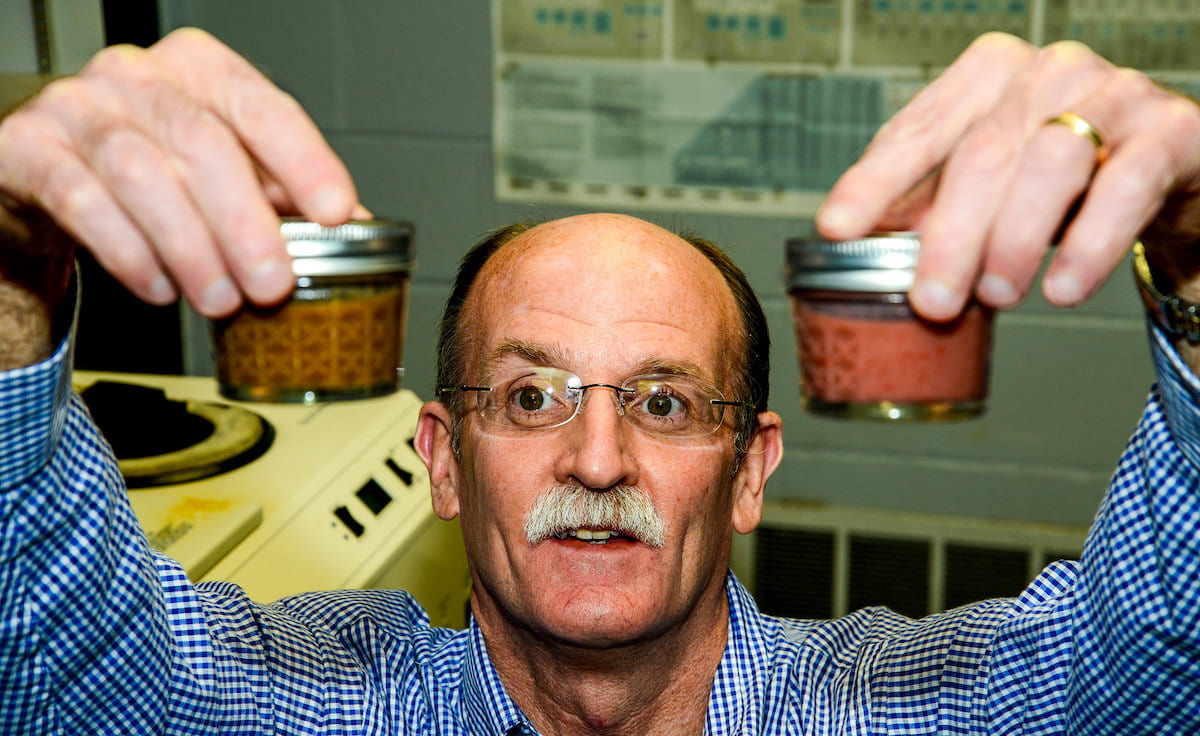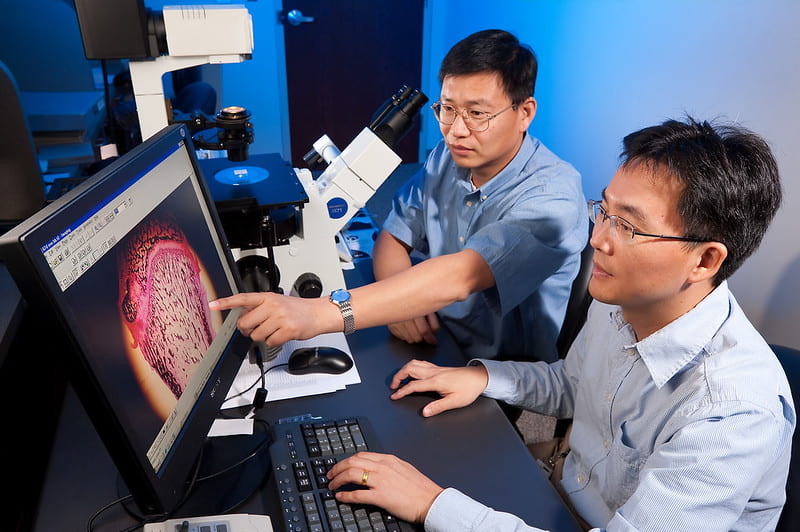Research Aims to Prove Childhood Health Benefits of Blueberry Extracts
Interdisciplinary team researching benefits of adding blueberry powder to snack foods
By Fred Miller – May 22, 2020

FOOD CHEMIST — Luke Howard studies how the chemical compounds in berries can be extracted and used in other foods to improve health benefits. He is now working with researchers at Arkansas Children’s Nutrition Center to see if adding the wild blueberry powder to snack foods provides benefits for bone health and growth, immune system development, and other health needs in children. (U of A System Division of Agriculture photo by Fred Miller)
Media Contact
Fred Miller
U of A System Division of Agriculture
Arkansas Agricultural Experiment Station
(479) 575-5647 | fmiller@uark.edu
FAYETTEVILLE, Ark. — An interdisciplinary team of Arkansas scientists wants to make sure kids eat more fruit, even if they have to be sneaky about it.
Don’t worry — the parents will be in on the caper.
Luke Howard, professor of food chemistry with the University of Arkansas System Division of Agriculture, is teaming up with Drs. Jin-Ran Chen, Eva Diaz and Sean Adams, University of Arkansas for Medical Sciences researchers at the Arkansas Children’s Nutrition Center in Little Rock to investigate the health benefits of adding freeze-dried blueberry powder to snack foods.
Dr. Eva Diaz, an M.D. and researcher in ACNC’s Physical Activity, Energetics and Metabolism Research Lab, said 75 percent of children ages 5 to 18 in the U.S. do not get enough fruit in their diets. (She added that 95 percent of the same age group don’t eat enough vegetables — but that’s a matter for other research projects.)
“Childhood is a critical window of opportunity to improve health through dietary changes,” Diaz said.
Food chemistry
Howard has investigated the phytonutrient compounds in fruits and their health benefits over more than two decades at the Arkansas Agricultural Experiment Station, the research arm of the Division of Agriculture. He has developed methods for extracting those compounds for use as healthy additives to foods.
For this research, Howard used freeze-dried wild, lowbush blueberries to capture phytonutrients called polyphenols that concentrate in the berries’ skins.
Because they are smaller than cultivated varieties, wild blueberries have higher concentrations of these polyphenols, Howard said. Human metabolism breaks down these polyphenols — including anthocyanins, chlorogenic acid and flavanols — into simpler phenolics that research has shown correlate to positive health effects.
Media Contact
Fred Miller
U of A System Division of Agriculture
Arkansas Agricultural Experiment Station
(479) 575-5647 | fmiller@uark.edu

BONES — Arkansas Children’s Nutrition Center investigators Jin-Ran Chen, left, and Xianli Wu use a fluorescent microscope to view inside a rat bone in studies to evaluate the effects of blueberries on bone function. The research is now advancing to a human clinical study by ACNC researcher Eva Diaz in collaboration with Luke Howard, a food chemist for the University of Arkansas System Division of Agriculture. (USDA/ARS photo by Stephen Ausmus)
Clinical studies
Chen, director of ACNC’s Bone Development Lab, showed that the polyphenols in Howard’s blueberry powder improved bone health and growth in research animals. With those results, he is ready to advance the study to human trials.
Diaz is spearheading that next step — funded by the U.S. Department of Agriculture’s Agricultural Research Service — to see if humans get the same benefits. In addition to working with Chen on bone health and growth in children, Diaz wants to investigate whether the additive has anti-inflammatory and immune system benefits.
The research will begin with a five-day pilot study to determine that a sufficient amount of the polyphenols are being delivered to the participants, Diaz said.
That will be followed by an eight-week study with 40 children aged 11-12, Diaz said. Each child in the study will receive blueberry-enriched snack foods created by the Division of Agriculture’s department of food science.
Howard said they produced five different snack food products — ice pops, oatmeal bars, graham cracker cookies, fruit juice and gummy candy. Each kid will eat two snacks per day over the eight weeks to obtain a regular daily amount of blueberry powder.
“ACNC wanted five treats so the kids would have some variety,” Howard said. “We didn’t want them to get tired of eating the same thing every day.”
They also wanted to make sure the kids would like the snacks. Han-Seok Seo, associate professor of sensory science in the division’s department of food science, conducted a taste test study.
The study, involving 60 children ages 7-10, showed some variability in how much they liked the treats after the first bite and how much they liked them after eating the whole thing, Seo said in a research article published in Food Research International .
“The oatmeal bars seemed to work best at delivering the polyphenols,” Howard said of Seo’s results. “The gummies were least effective, probably because the medium of the gummies is less efficient at releasing the polyphenols.”
The oatmeal bars and the cookies also seemed to be the favorites, Seo noted. Howard said that preference may be a critical factor in determining their commercial value down the road.
Despite the differences in the ability of each food to release the polyphenols, Seo concluded that all the blueberry-enriched snacks would serve as appropriate vehicles for delivering the phytonutrients.
Final analysis
In the upcoming clinical studies, blood draw and urine samples from the participants will be analyzed for markers that indicate the bodies’ use of the phytonutrients. The data will be correlated with evidence of the positive health outcomes that Chen and Diaz are looking for — net positive bone growth, and modulation of inflammation and immune system response.
Positive results from this investigation will lead to more basic research to establish the benefits of blueberry supplementation, Diaz said. That work would seek to identify the associations between the foods and the health benefits, and discover the mechanisms of action that drive them.
In the meantime, both Diaz and Howard said positive results from this study might indicate that blueberry-enriched food products are worth moving toward commercial production and retail. Healthier oatmeal bars and cookies could end up on the supermarket shelves.
Just don’t tell the kids it’s good for them.
To learn more about the Division of Agriculture Research, visit the Arkansas Agricultural Experiment Station website. Follow us on Twitter at @ArkAgResearch and Instagram at ArkAgResearch.
About the Division of Agriculture
The University of Arkansas System Division of Agriculture’s mission is to strengthen agriculture, communities, and families by connecting trusted research to the adoption of best practices. Through the Agricultural Experiment Station and the Cooperative Extension Service, the Division of Agriculture conducts research and extension work within the nation’s historic land grant education system.
The Division of Agriculture is one of 20 entities within the University of Arkansas System. It has offices in all 75 counties in Arkansas and faculty on five system campuses.
The University of Arkansas System Division of Agriculture offers all its Extension and Research programs and services without regard to race, color, sex, gender identity, sexual orientation, national origin, religion, age, disability, marital or veteran status, genetic information, or any other legally protected status, and is an Affirmative Action/Equal Opportunity Employer.
